 by "ttyymmnn" (ttyymmnn)
by "ttyymmnn" (ttyymmnn)
Published 05/26/2017 at 12:35
 by "ttyymmnn" (ttyymmnn)
by "ttyymmnn" (ttyymmnn)
Published 05/26/2017 at 12:35
Tags: Planelopnik
; planelopnik history
STARS: 8
Welcome to This Date in Aviation History , getting you caught up on milestones, important historical events and people in aviation from May 24 through May 26.
!!! UNKNOWN CONTENT TYPE !!!
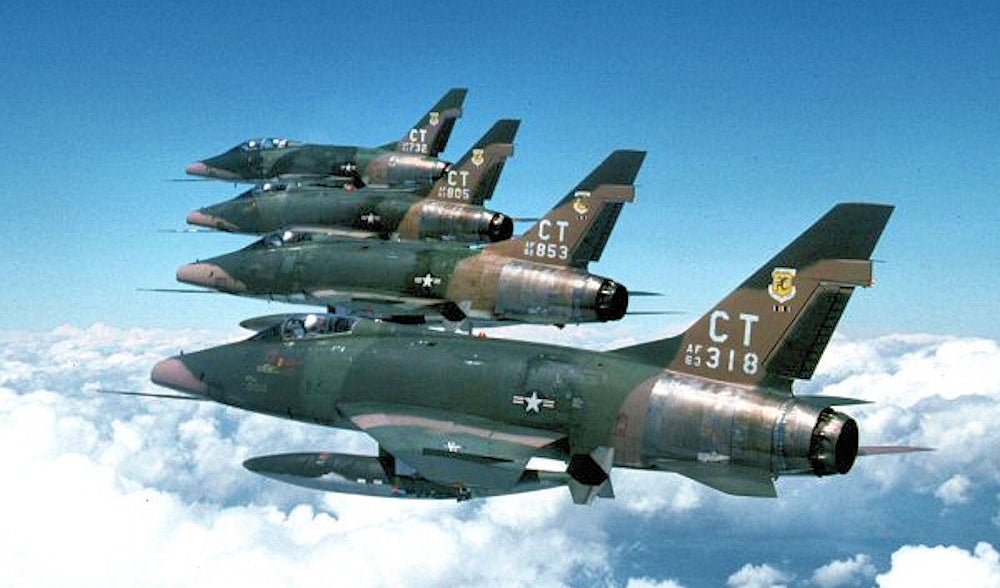
May 25, 1953 – The first flight of the North American F-100 Super Sabre. The 1950s was an extraordinary period for fighter aircraft development, as early straight-winged jet fighters were quickly supplanted by faster swept-wing designs, and new aircraft were often adopted for service before they could be thoroughly tested. But perhaps more than anything, the 1950s was an era notable for the quest for ever greater speeds. Though fighters had already broken the sound barrier in short bursts of speed, the US Air Force was looking for an fighter that could fly at sustained supersonic speeds. North American had made a solid reputation for itself in WWII with the remarkable P-51 Mustang , and they followed up the success of the Mustang with the swept-wing F-86 Sabre , which proved its mettle in the skies over Korea during the Korean War. For their next world-beater, North American turned to the F-86 as a basis for the design of an even more powerful fighter. Work on the F-100 began in 1951 with a company-funded aircraft called Sabre 45, a designation that came from the aircraft’s 45-degree wing sweep (the F-86 employed 35 degrees of sweep). Though much more powerful and more streamlined, the F-100 still shared its predecessor’s nose air intake and single engine, though the Super Sabre used a General Electric J57 engine in place of the Sabre’s J47 which delivered nearly twice the power. The Super Sabre also made far more use of titanium in its structure, a metal known for both its lightness and strength. The first prototype Super Sabre reached Mach 1.07 on its first flight, even though it was fitted with a purposefully de-rated engine. Due to delays in production of the Republic F-84F Thunderstreak , the Air Force accepted the Super Sabre immediately in 1953, and delivery to Air Force squadrons began in 1954. However, the Super Sabre began to show worrying handling characteristics, and a series of crashes caused the fleet to be grounded in November 1954. Flight tests showed that, during roll maneuvers, the F-100 had a nasty inclination to pitch up and down simultaneously, and the highly-swept wings made the Super Sabre susceptible to pitch up at low speeds, something that pilots referred to as the “ Sabre dance .” Engineers corrected these problems by enlarging the vertical stabilizer by 27-percent, while also increasing the wingspan by 26 inches. With the control problems solved, deliveries of the Super Sabre restarted and existing aircraft were returned to flying status.
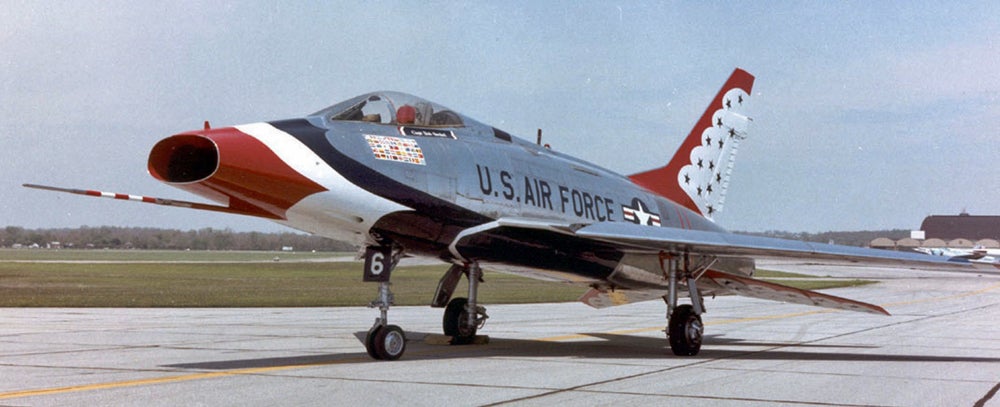
But even with the return of the F-100A, the Air Force began phasing the “Hun” out of service, and it was officially removed from active service by 1961. But that wasn’t the end of the Super Sabre. The F-100A was returned to active duty due to rising tensions in Eastern Europe while work continued on the development of a fighter-bomber version, which became the F-100C, a variant with a more powerful engine that was developed for nuclear toss bombing . It was the F-100D, though, that served in the greatest numbers and with the greatest effect. The Super Sabre went to Vietnam in 1961 and served for 10 years, becoming the longest serving fighter bomber of the war. At the end of the war, Huns had fired over 4 million rounds of 20mm ammunition, dropped 30 million pounds of bombs and delivered over 10 million pounds of napalm. Two-seat F-100F Super Sabres served as forward air controllers, flew reconnaissance missions, and carried out search and rescue missions. In a testament to its incredible speed, the Super Sabre set numerous speed records and won the Bendix Trophy in 1955. It was also the first jet fighter to fly over the North Pole, and was flown by the USAF Thunderbirds from 1956 to 1968. Just under 2,300 Super Sabres were produced, and it was retired from frontline service in 1979, though it continued serving with Air National Guard units until 1988. (US Air Force photos)
!!! UNKNOWN CONTENT TYPE !!!
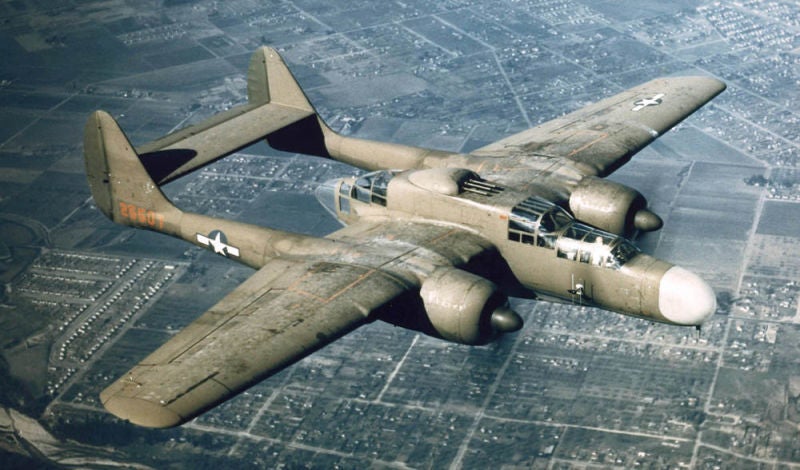
May 26, 1942 – The first flight of the Northrop XP-61 Black Widow. In modern times, it’s hard, or even impossible, to imagine a fighter without a radar. Powerful modern radars have made possible fighters that can fly in all weather conditions, day or night, and attack enemy targets that are out of the pilot’s range of sight. But during WWII, the roles of day fighter and night fighter were, for the most part, separate. Smaller, more agile fighters did the fighting by day, while larger aircraft capable of carrying the early heavy radar sets fought by night. British development of radar (an acronym coined by the United States Navy for “radio detection and ranging”) had been progressing steadily since the early days of the war, and its land-based radar stations proved vital during the Battle of Britain in detecting incoming German bombers and directing RAF fighters to intercept them. By late summer of 1940, the British finally fielded an airborne radar unit, called the Airborne Intercept (AI) radar, but they didn’t have an aircraft that could carry it. So they requested aircraft designs from every Allied manufacturer, one of which was Northrop. Jack Northrop understood that any aircraft capable of the speed, altitude, range and firepower that the RAF requested, along with the ability to carry the heavy radar, needed to be big and would require more than one engine. While work on the AI was progressing in England, the British Tizard Mission came to the US to receive assistance in developing their new technologies away from the danger of German bombing, and they brought with them their AI radar. With the exchange of technologies, the US saw the potential for making their own night fighter, and the Army made a formal request for such an aircraft. With the head start Northrop had from working on the British proposal, his new XP-61 beat out the only competitor for the contract, the Douglas XA-26A, a night-fighter based on the Douglas A-26 Invader . Northrop’s design placed a large gondola between two booms housing 18-cylinder Pratt & Whitney R-2800 Double Wasp radial engines. Following the earlier British request, the gondola housed two machine gun turrets, one in the nose and one in the rear, each with four guns. Eventually, the ventral turret was removed, and the rear turret was replaced with a powered turret on the top of the fuselage, which was routinely fixed forward to provide more attacking firepower. Northrop then finalized the design by placing four 20mm cannons in the belly of the aircraft, making the Black Widow one of the few American aircraft to mount four cannons. Though history notes the Black Widow as America’s first dedicated night fighter, it was difficult, by the standards of contemporary fighter design, to call the Black Widow a fighter. It was a true behemoth, with a wingspan of 60 feet (8 feet longer than the Lockheed P-38 Lightning ), a height of nearly 15 feet, and an empty weight of over 23,000 pounds. When Black Widows arrived in Europe in the spring of 1944, Army commanders were convinced that the P-61 was too slow and cumbersome to counter German aircraft. Instead, they wanted to procure the British de Havilland Mosquito , and even went so far as to organize a competition between the two aircraft. However, with a few tweaks to the engine to improve performance, the Black Widow was able to outperform the Mossie in speed and rate of climb and, with its special “ Zap Flaps ” and retractable spoilers, the P-61 could even outmaneuver the Mosquito. While still unable to outduel German single-engine fighters, the Black Widow proved quite effective against German bombers and fighter-bombers. In the Pacific, the Black Widow arrived too late to have a significant impact on the war, but it did play a vital role in the rescue of over 500 Allied prisoners from the Cabanatuan prison camp in the Philippines. Though it never fired a shot, a lone P-61 performed aerobatics over the camp to distract Japanese guards while Army Rangers positioned themselves for an assault. A Black Widow is also unofficially credited with scoring the last aerial victory of WWII.
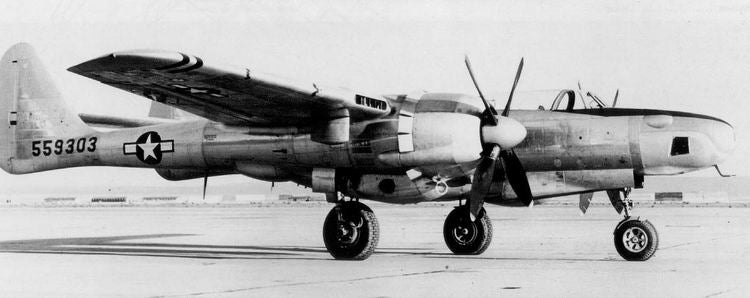
While many WWII aircraft were retired quickly with the end of the war, the Black Widow, as America’s only night fighter, soldiered on until the US produced a jet-powered alternative, which eventually came in the form of the Northrop F-89 Scorpion . P-61s also played a leading role in research into ejection seat technology, and took part in the Thunderstorm Project , America’s first large-scale scientific study of thunderstorms. Northrop also developed a reconnaissance variant called the F-15 Reporter , which removed the top portion of the central gondola and housed of the two-man crew under a single canopy. While the final P-61 flight was made in 1954, the Reporter served in various roles until 1968. (US Air Force photos) .
!!! UNKNOWN CONTENT TYPE !!!
!!! UNKNOWN CONTENT TYPE !!!
!!! UNKNOWN CONTENT TYPE !!!
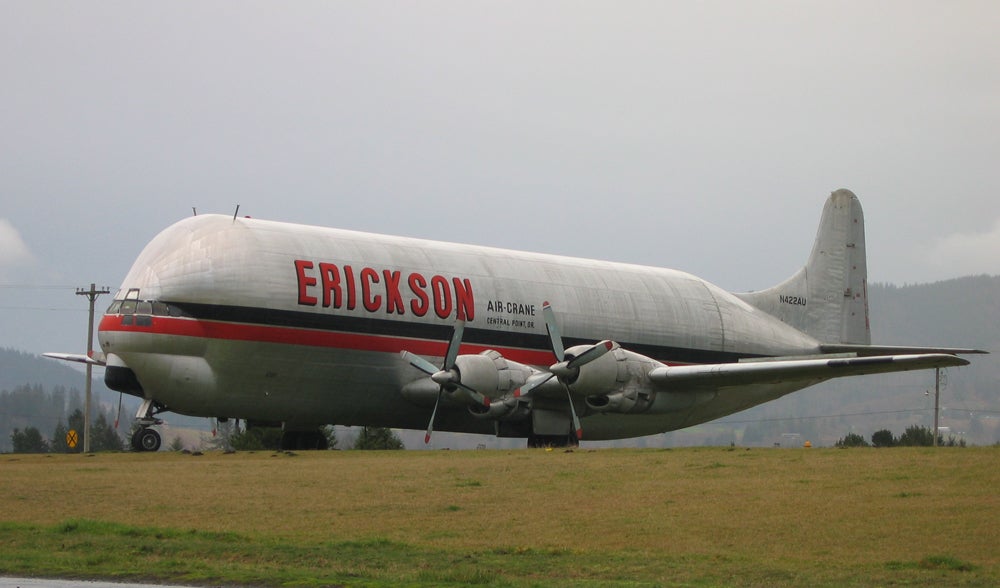
May 24, 1967 – The first flight of the Aero Spacelines Mini Guppy, an oversized cargo aircraft developed from the Boeing C-97 Stratofreighter . Two Mini Guppies were built, using parts salvaged from the Stratofreighter along with parts from the Boeing 377 Stratocruiser airliner. While the Mini Guppy retained the wings, engine and lower fuselage of the C-97/377, the upper fuselage was significantly enlarged by the addition of a second, oversized fuselage section. Loading the aircraft was achieved through a hinged tail section. The first Mini Guppy was retired in 1995, while the second was given upgraded Allison 501 turboprop engines and renamed the Mini Guppy Turbine. However, that aircraft was lost in a crash in 1970. (Photo by SpiralOut via Wikimedia Commons )
!!! UNKNOWN CONTENT TYPE !!!
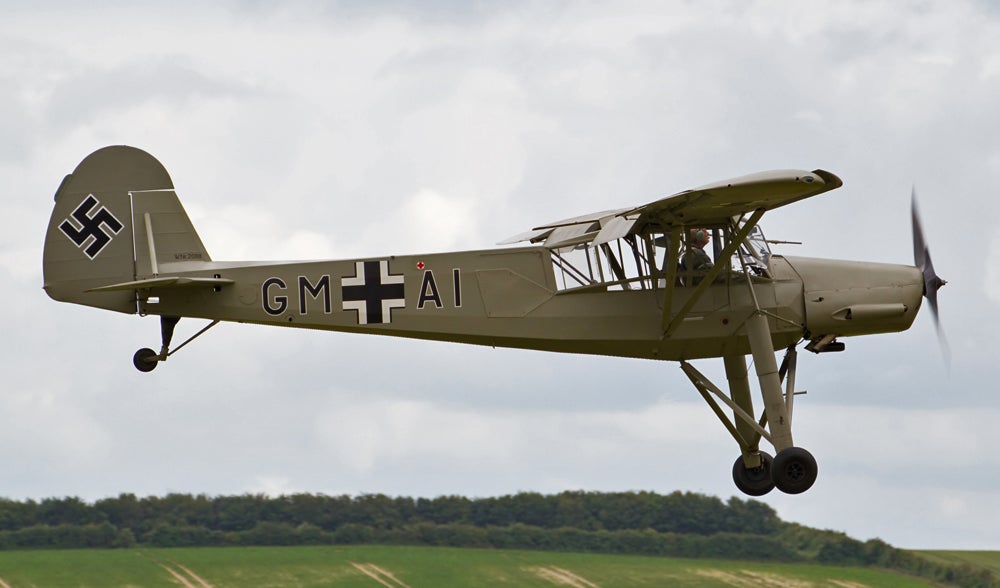
May 24, 1936 – The first flight of The Fieseler Storch Fi 156,
a small aircraft developed for the German Aviation Ministry (
Reichsluftfahrtministerium
)
for liaison, forward air control and medevac duties. The
Storch
was selected over the other contenders because of its outstanding short takeoff and landing (STOL) characteristics and other design elements such as folding wings that made the
Storch
easy to tow or transport, and long landing gear with shock absorbers for operations from crude runways. The
Storch
gained fame for its role in the rescue of ousted Italian Prime Minister
Benito Mussolini
from the rocky mountaintop ski resort of San Grasso in
Operation Eiche
(
Oak
) in 1943. Mussolini had been arrested and held at the mountaintop hotel, but was rescued by German gliderborne paratroops and flown off the rock-strewn mountaintop by a
Storch
, the only aircraft capable of operating from the site.
(Photo by Tony Hisgett via
Wikimedia Commons
)
!!! UNKNOWN CONTENT TYPE !!!
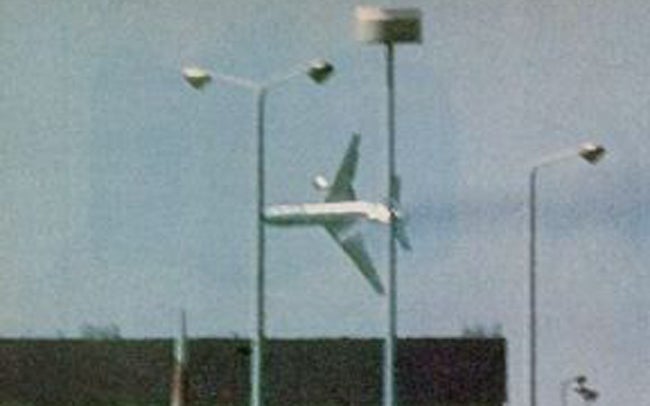
May 25, 1979 – The crash of American Airlines Flight 191, a regularly scheduled flight from Chicago’s O’Hare International Airport to Los Angeles International Airport. The wide body airliner crashed during takeoff when the left engine of the McDonnell Douglas DC-10-10 (N110AA) separated from the wing, severing hydraulic lines, damaging the left wing’s leading edge, and causing an uncommanded retraction of the leading edge slats. As the aircraft continued to takeoff, the unbalanced configuration of the wing slats caused the left wing to stall while the right wing was still providing lift, and the aircraft rolled to the left until partially inverted before crashing in a nearby field. The crash killed all 271 passengers and crew as well as 2 people on the ground, and it remains the deadliest aviation accident on US soil. The engine separation was found to have been caused by faulty maintenance practices performed by American Airlines, and not a design defect. As a result, American Airlines was fined $500,000 for improper maintenance procedures. (Photo by Michael Laughlin)
!!! UNKNOWN CONTENT TYPE !!!
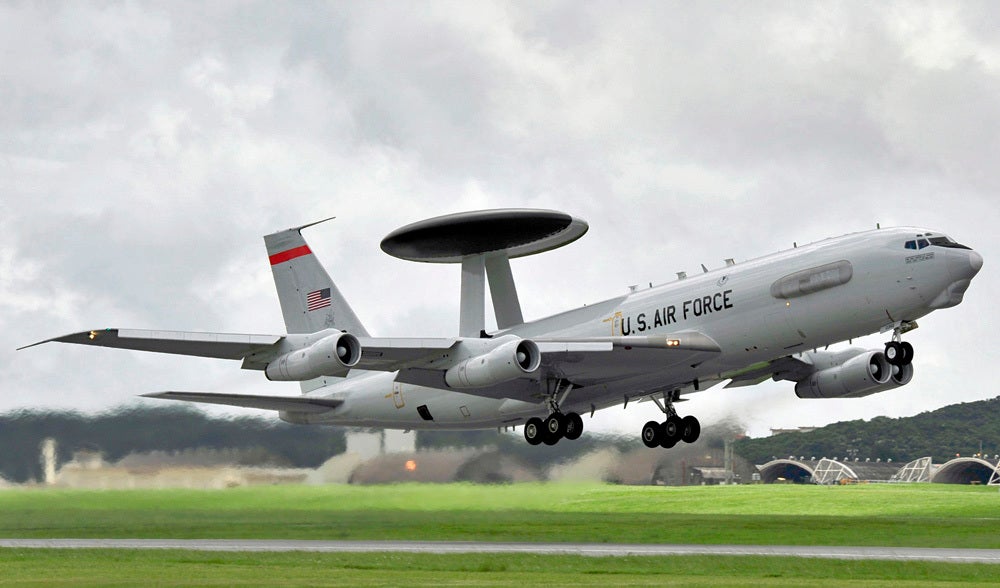
May 25, 1976 – The first flight of the Boeing E-3 Sentry, an airborne early warning and control (AEWC) aircraft more commonly known as AWACS that was developed to replace the Lockheed EC-121 Warning Star . The E-3 was derived from the civilian Boeing 707 airliner, and uses its dorsal radome and other sensors to monitor the battlefield and the airspace around it. The Sentry then provides enhanced situational awareness to battlefield commanders, and helps control air and ground forces necessary for interdiction, reconnaissance, airlift and close air support. The E-3 entered service with the US Air Force in 1977, and has since been adopted by NATO, the Royal Air Force and Saudi Arabia. Produced from 1977-1992, a total of 68 have been built and it remains operational. (US Air Force photo)
!!! UNKNOWN CONTENT TYPE !!!
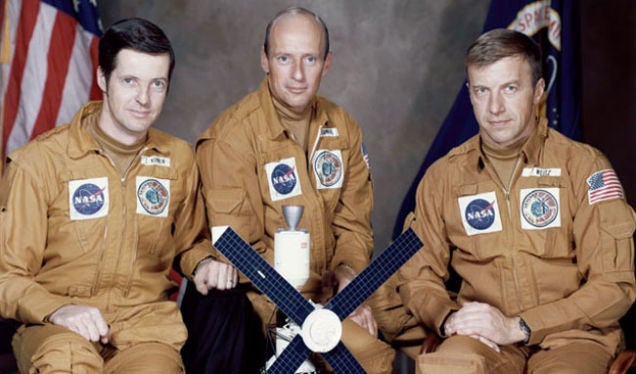
May 25, 1973 – The launch of Skylab 2, the first of three manned missions to Skylab . The United States’ first orbital space station, Skylab was launched on May 14, 1973 (Skylab 1) and remained in orbit for six years. Skylab 2 astronauts Joseph Kerwin , Pete Conrad and Paul Weitz were launched into orbit atop a Saturn IB rocket and docked with the station on May 26. They remained onboard the station for 28 days and set a new record for spaceflight duration. The crew also set records for the greatest distance traveled and the greatest mass docked in space. A primary objective of the mission was to repair a jammed solar array on the station and cover the station with a solar blanket to take the place of a damaged heat shield. In addition to other repairs, the crew also carried out 392 hours of experiments. The Skylab 2 Command Module returned to Earth on June 22, 1973 and was recovered by the USS Ticonderoga (CV-14) near San Diego. (NASA photo)
!!! UNKNOWN CONTENT TYPE !!!
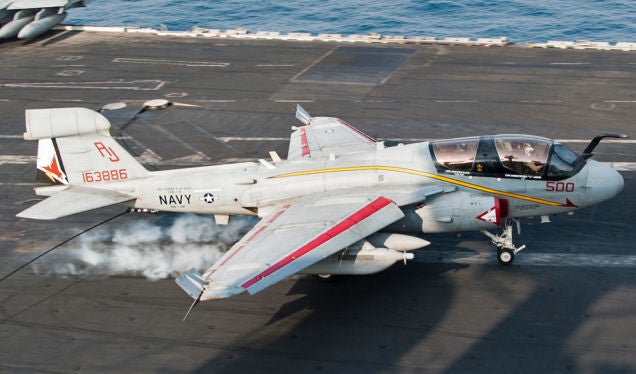
May 25, 1968 – The first flight of the Northrop Grumman EA-6B Prowler.
Following the success of the two-man
Grumman EA-6A “Electric Intruder”
electronic warfare aircraft in Vietnam, Grumman stretched the fuselage to add a second row of seating for electronics warfare officers, added an antenna fairing to the vertical stabilizer, and placed more powerful radars in the nose to produce the EA-6B. Introduced in 1971, Prowlers replaced the
Douglas EKA-3B Skywarrior
and flew 720 sorties in support of Navy bombers and USAF
Boeing B-52 Stratofortresses
in Vietnam. The Prowler also served in Grenada, Afghanistan, Iraq and Syria, and was recently retired from service and replaced by the newer
Boeing EA-18G Growler
.
(US Navy photo)
!!! UNKNOWN CONTENT TYPE !!!
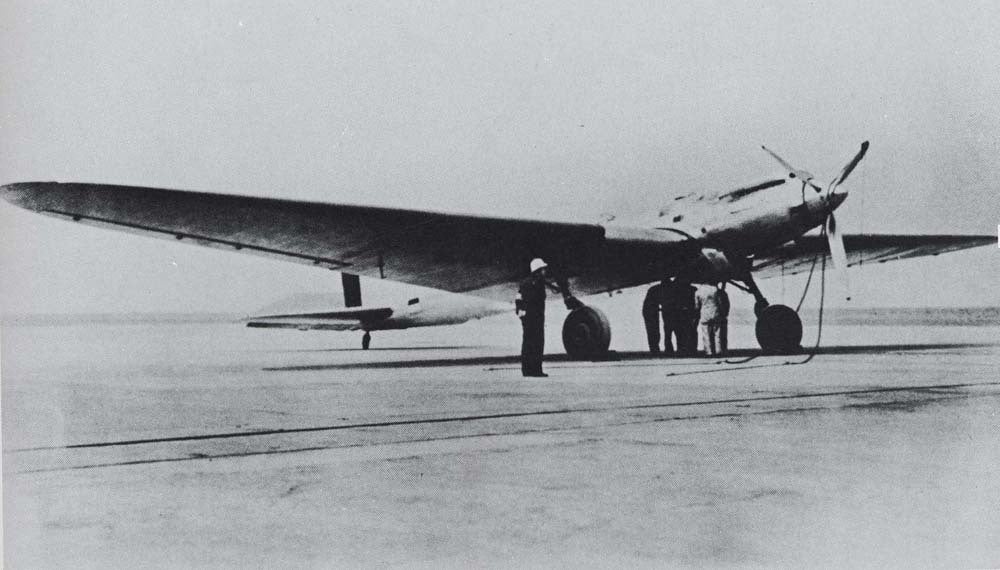
May 25, 1937 – The first flight of the Gasuden Koken, a long-range research aircraft developed by the Tokyo Gas and Electric Industry (Gasuden) in an effort to break the world record for the longest closed circuit flight (taking off and landing from the same point). The plane was powered by a single Kawasaki V-12 engine that provided a top speed of 155 mph and had a wingspan of over 91 feet. The fuselage was constructed of metal, but the outer wings and control surfaces were covered in fabric. Following two unsuccessful attempts at the record, the Gasuden Koken took off from Kisarazu, Chiba on May 13, 1938 and made 29 laps of a 249-mile circuit. It landed two-and-a-half days later, having flown 7,239 miles, the only record ever set by Japan that was recognized by the Fédération Aéronautique Internationale . The record was broken just one year later by an Italian Savoia-Marchetti SM.82 which flew 8,038 mi. (Photo author unknown)
!!! UNKNOWN CONTENT TYPE !!!
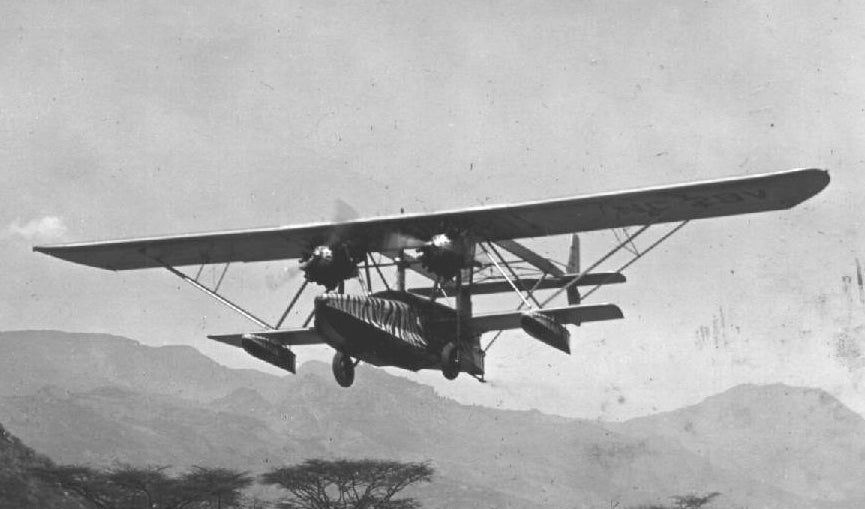
May 25, 1937 – The first flight of the Sikorsky S-38, a twin-engined sesquiplane (a biplane in which one wing is significantly smaller than the other) amphibious aircraft that could accommodate 8 passengers and was Igor Sikorsky’s first widely-produced flying boat. Developed from the S-34 and S-36 , both amphibious sesquiplanes that were built in very small numbers, the S-38 flew for Pan American Airways, the US Army, where it was known as the C-6, and the US Navy, where it was known as the PS-3. The S-38 was also popular with civilian pilots, and was operated by safari companies in Africa. Sikorsky built a total of 101 S-38s. (Photo via the Martin and Osa Johnson Safari Museum )
!!! UNKNOWN CONTENT TYPE !!!
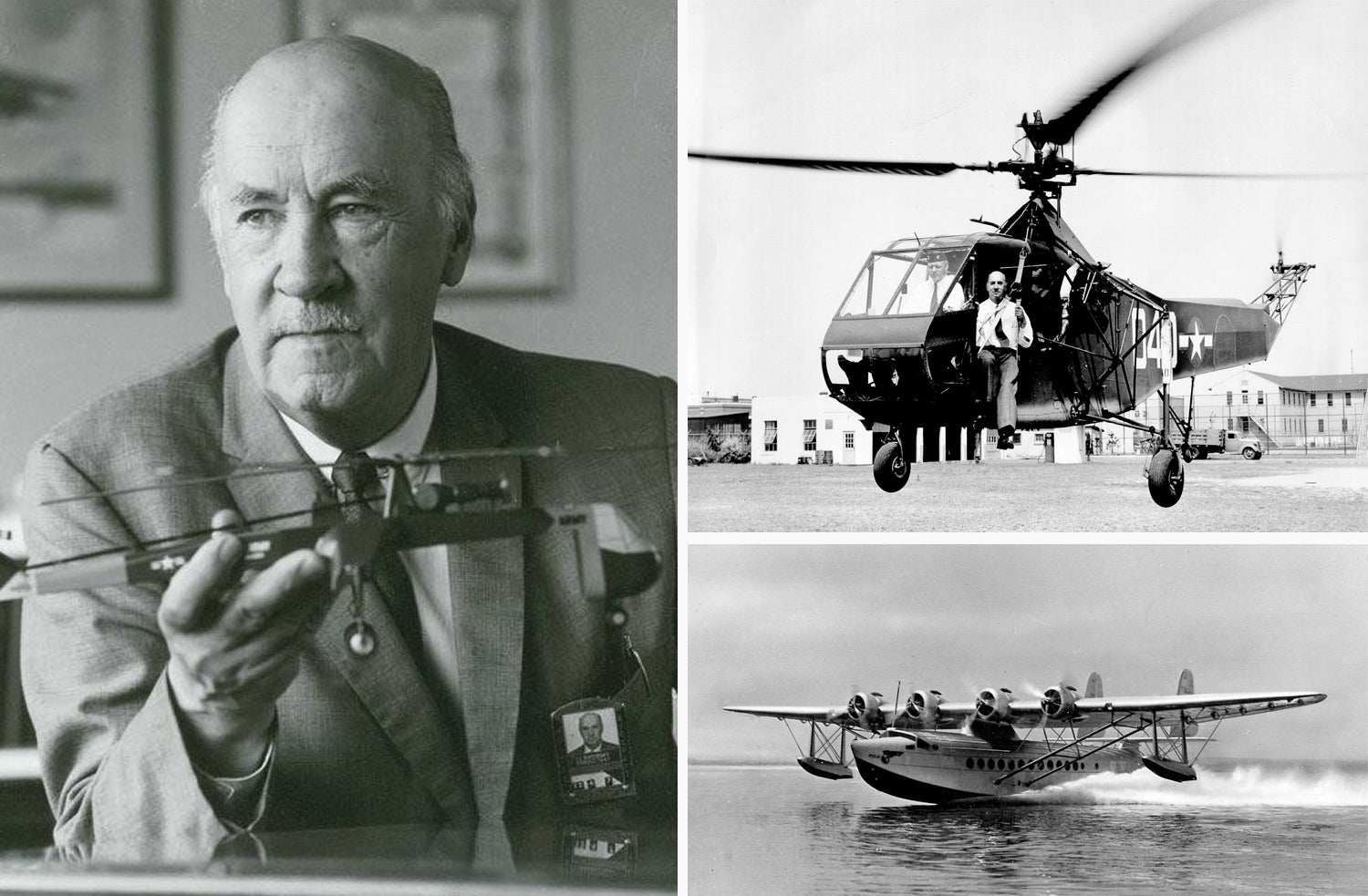
May 25, 1889 – The birth of Igor Sikorsky. Russian-born Igor Sikorsky is best known for the development of one of the first successful helicopters, but he started his career as a designer of fixed-wing aircraft. Before emigrating to the United States in 1919, Sikorsky designed and flew the Russky Vityaz , the world’s first multi-engine fixed-wing aircraft, and the Ilya Muromets , the world’s first large airliner. After coming to the US, Sikorsky founded the Sikorsky Aircraft Corporation in 1923 and produced the S-42 flying boat for Pan American Airways. But it was in rotary-winged aircraft that Sikorsky made his greatest mark on aviation history, first with the VS-300 in 1939, the first helicopter to use a single engine to power both main and tail rotors, and the R-4 , the world’s first production helicopter, in 1942. (Sikorsky photo via Smithsonian Air and Space Museum ; R-4 photo via US Coast Guard; S-42 photo via US Navy)
!!! UNKNOWN CONTENT TYPE !!!
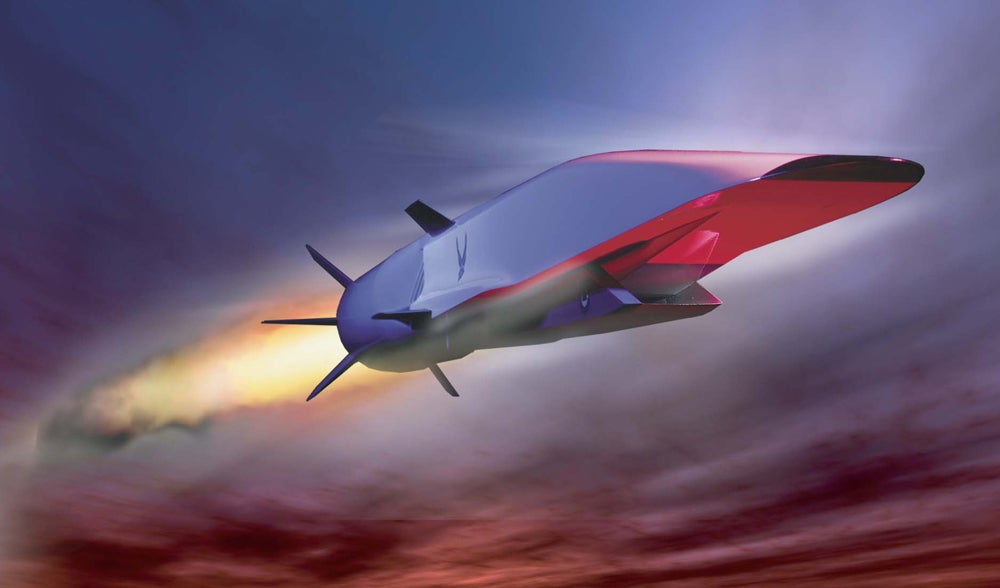
May 26, 2010 – The first flight of the Boeing X-51A WaveRider, an unmanned, hypersonic research aircraft powered by a scramjet engine and taking its name from the compression lift that is created by its own shockwaves that is used to generate lift. The X-51 is carried aloft by a Boeing B-52H mothership to an altitude of 50,000 feet, then released while attached to a solid rocket booster that propels the X-51 to a speed of Mach 4.5. The booster is then jettisoned, and the aircraft flies under power from a Pratt & Whitney Rocketdyne scramjet engine. Following its maiden flight, and two flights flights with mixed results, the X-51 accelerated to Mach 5.1 and flew for 210 seconds before running out of fuel and crashing into the Pacific Ocean. (US Air Force illustration)
!!! UNKNOWN CONTENT TYPE !!!

May 26, 1951 – The birth of Sally Ride,
a physicist, astronaut, and the first American woman in space. Ride joined NASA in 1978 and went to space in 1983 as a Mission Specialist on board Space Shuttle
Challenger
on mission
STS-7
, becoming the not only the first American woman in space but also the youngest American astronaut to fly in space at age 32. Ride went to space a second time the following year, again on
Challenger
, as a Mission Specialist on
ST-41-G
. Ride left NASA in 1987, but served on the investigation committees into the
Challenger
and
Columbia
disasters. After teaching physics at the University of California, San Diego, Ride died of pancreatic cancer in 2012 at age 61.
(National Archives photo)
!!! UNKNOWN CONTENT TYPE !!!
!!! UNKNOWN CONTENT TYPE !!!
!!! UNKNOWN CONTENT TYPE !!!
!!! UNKNOWN CONTENT TYPE !!!
!!! UNKNOWN CONTENT TYPE !!!
!!! UNKNOWN CONTENT TYPE !!!
!!! UNKNOWN CONTENT TYPE !!!
If you enjoy these Aviation History posts, please let me know in the comments. And if you missed any of the past articles, you can find them all at Planelopnik History . You can also find more stories about aviation and aviators at Wingspan and Planes You’ve (Probably) Never Heard Of .
!!! UNKNOWN CONTENT TYPE !!!
 "For Sweden" (rallybeetle)
"For Sweden" (rallybeetle)
05/26/2017 at 12:42, STARS: 3
It’s worth nothing that the American DC-10 mechanics that worked on the Flight 191 aircraft willfully violated procedure. It wasn’t an honest mistake.
 "MonkeePuzzle" (monkeypuzzle)
"MonkeePuzzle" (monkeypuzzle)
05/26/2017 at 12:50, STARS: 2
I do love that anything as large as the guppy could be called “mini” :D
of course, I assume this is in relation to other guppies, but still, its like when you ironically call a massive wrestler “tiny”
 "RamblinRover Luxury-Yacht" (ramblininexile)
"RamblinRover Luxury-Yacht" (ramblininexile)
05/26/2017 at 12:51, STARS: 2
A note on the Storch: There’s a modernized slightly downsized kit/plans version available today called the Slepcev Storch. With a couple of minor tweaks to the already very good aero, its STOL performance is supposed to be
incredible.

05/26/2017 at 13:04, STARS: 1
Monogram’s P-61 was one of the first model kits I built; it’s a really interesting build, lots of green zinc chromate and gloss black. The plane itself is fascinating too. The 20mm cannon were originally placed in the wings, but were moved to the belly to clean up the wings, increase fuel capacity, and improve their effectiveness. There were also problems with the turret, especially when it rotated, and it was removed on several variants of the A model. It’s also safe to say someone at LucasFilm liked the plane too:
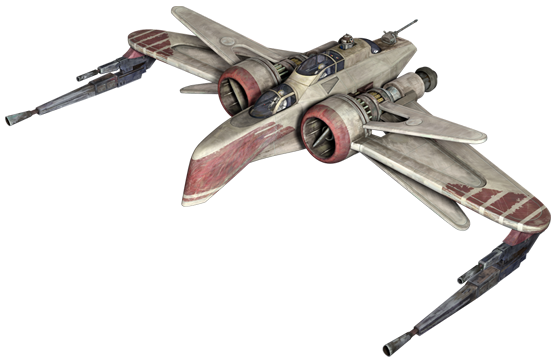
 "ttyymmnn" (ttyymmnn)
"ttyymmnn" (ttyymmnn)
05/26/2017 at 13:06, STARS: 1
When I was a kid, Starblazers was blowing up TV, and my friend and I went about designing our own space fighters. We took a book of US fighters which had three-view drawings and traced many of them as the basis for our fighters. The fuselage of the Black Widow served the purpose very nicely. I think I still have those drawings somewhere.
 "ttyymmnn" (ttyymmnn)
"ttyymmnn" (ttyymmnn)
05/26/2017 at 13:07, STARS: 0
I imagine so. Take a plane that was already STOL and put a more powerful engine in it and it would probably leap into the sky.
 "ttyymmnn" (ttyymmnn)
"ttyymmnn" (ttyymmnn)
05/26/2017 at 13:08, STARS: 1
Yes, it’s all relative.
 "ttyymmnn" (ttyymmnn)
"ttyymmnn" (ttyymmnn)
05/26/2017 at 13:09, STARS: 2
It is worth noting. It’s also worth noting that AA got fined only $500,000 for killing 271 people.
 "For Sweden" (rallybeetle)
"For Sweden" (rallybeetle)
05/26/2017 at 13:12, STARS: 0
That’s about $1.8 million on today’s money, but regulators are extremely hesitant to impose severe fines and risk damaging the Just Culture safety programs.
 "WilliamsSW" (williamssw)
"WilliamsSW" (williamssw)
05/26/2017 at 13:19, STARS: 0
And, as I recall, that incorrect procedure was commonplace at AA, and I think also at another major airline - in direct conflict with MD’s procedure.
 "ttyymmnn" (ttyymmnn)
"ttyymmnn" (ttyymmnn)
05/26/2017 at 13:22, STARS: 2
That’s what happens when you have a government agency that is charged with both policing and promoting an industry.
 "McMike" (mcmike)
"McMike" (mcmike)
05/26/2017 at 14:54, STARS: 1
Sally Ride was also really, really good at keeping secrets.
She was posthumously acknowledged as the first LBGT astronaut
.
 "Viggen" (viggen37)
"Viggen" (viggen37)
05/26/2017 at 15:01, STARS: 0
The Hun! Been fortunate enough to see one fly at an airshow. When that afterburner kicks in, you feel it.
 "ttyymmnn" (ttyymmnn)
"ttyymmnn" (ttyymmnn)
05/26/2017 at 15:12, STARS: 0
I’ve never seen one. That would be a blast. I saw a trio of F-86s at a show in Ft. Worth once. The Sabre is one of my faves, and I must have taken 100 pictures of them.
 "Viggen" (viggen37)
"Viggen" (viggen37)
05/26/2017 at 15:47, STARS: 0
Some potato pictures from 2010:

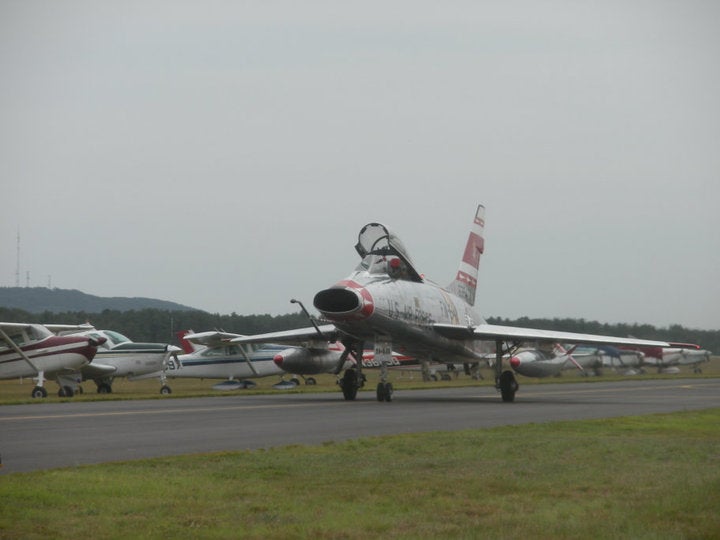
 "ttyymmnn" (ttyymmnn)
"ttyymmnn" (ttyymmnn)
05/26/2017 at 15:48, STARS: 0
That’s a big bird.
 "X37.9XXS" (x379xxs)
"X37.9XXS" (x379xxs)
05/27/2017 at 10:44, STARS: 0
Geological ages ago, I used to provide security for F100D’s in the UK. My all-time favorite story deals with a Victor Alert exercise that was not announced. The pilot refused to get into the aircraft. He figured that his life expectancy over Eastern Europe was approximately 30 seconds and he WAS NOT going to go.
And, for irony, my beloved wife was born in Kraszewo, Poland, which is literally 4 klicks away from Królewo Malborskie, which is the site of the 22nd Polish Air Base. During the Cold War, Królewo Malborskie was one of the prime USAFE targets
 "ttyymmnn" (ttyymmnn)
"ttyymmnn" (ttyymmnn)
05/27/2017 at 11:41, STARS: 0
So, did he go? It sounds like maybe being an air force pilot wasn’t the best career choice for this guy.
 "X37.9XXS" (x379xxs)
"X37.9XXS" (x379xxs)
05/27/2017 at 11:50, STARS: 1
No, he refused point-blank.
I heard that he was allowed to resign his commission and return to the States